| The Palazzo Pubblico, complete with chapel and meeting rooms, once housed the Podestà and the Council; today it is a kind of town hall. Made of red brick (typical of Siena) with a travertine base, it presents the image of a fortress, "but, where a working fortress would have real machicolations, this civic fortress has only heavy corbels resembling machicolations" (Norman 41). The blind arcade on the ground level suggests commercialism rather than fortification as well. The Gothic mullioned windows were later copied in other Sienese buildings. The Palazzo Pubblico is the most monumental building surrounding the Campo, the most important public space in Siena. The Campo was paved in 1333-34, signalling its importance in civic life. The Campo is also famous as the site for the Palio (horse race) as well as other yearly events. The Cappella di Piazza, a small chapel, is to the left, above which rises the bell-tower. |
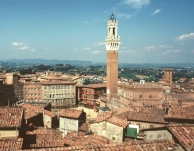 |
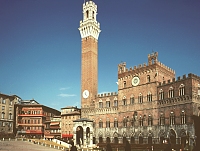 |
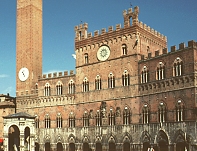 |
| |
|
The Chapel of the Square by Giovanni di Agostino and Giovanni di Cecco; detail of center; the small interior courtyardThe Chapel of the Square was built from 1352-76 as the fulfillment of a vow made during the plague of 1348; the upper section was added in the 15th century. On the lower level pillars have niches bearing statues of the twelve Apostles; and a fresco, now damaged, is above the altar in the rear. The central portion of the Palazzo Pubblico has a disk bearing a monogram for Christ while the sides have two wolves of stone. The Roman she-wolf is a symbol of the city, since by tradition Siena was founded by the son of Remus, who was nursed by a wolf. The interior courtyard is one of the entrances into the Palazzo and adjoins the wing of the Podestà. |
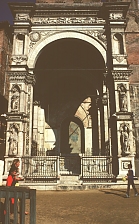 |
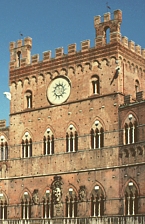 |
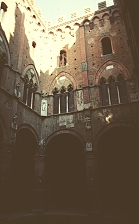 |
| |
|
 |
The bell tower (photographed about 20 years after the other images on this page)Torre del Mangia, a tall bell-tower--102M to the tip of the ironwork, was built between 1325-44. The tallest tower in the city, and taller than the one on the Palazzo Vecchio built somewhat earlier in Florence, it rang the time and announced curfews, as well as calling the Council to meetings. |


 Click here to return to index of art historical sites.
Click here to return to index of art historical sites.
 Click here to return to index of artists and architects.
Click here to return to index of artists and architects.
 Click here to return to chronological index.
Click here to return to chronological index.
